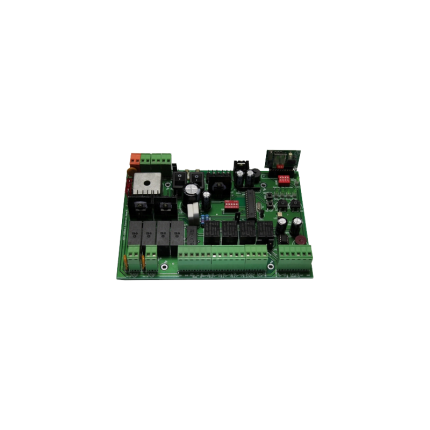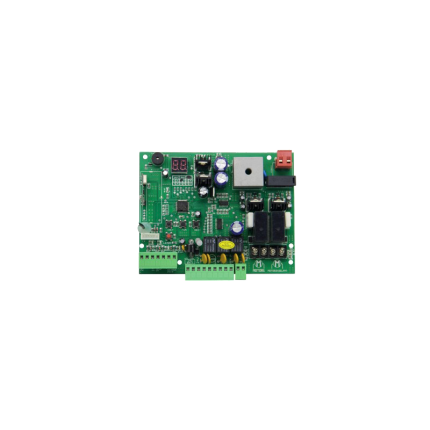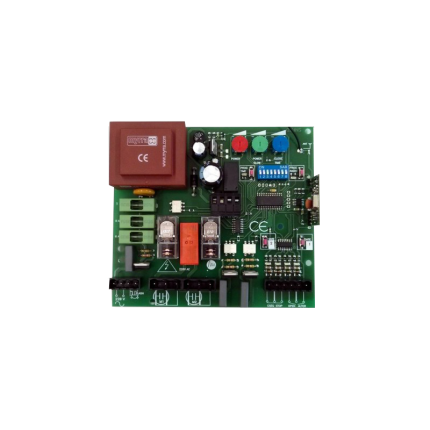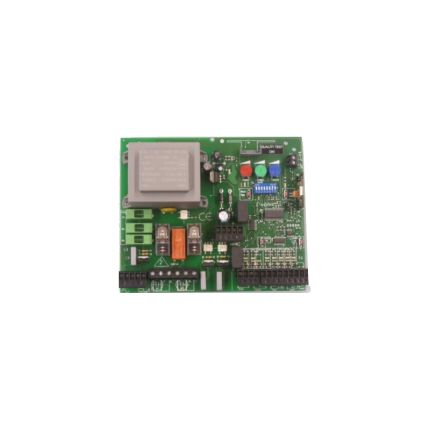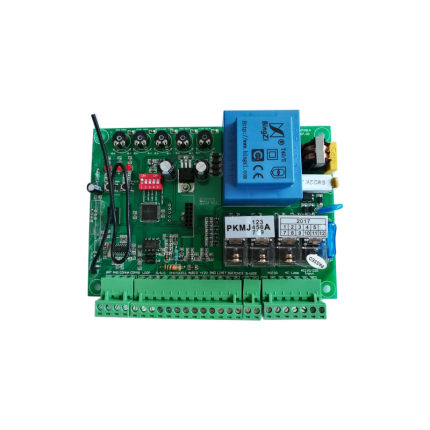main
Swing gate operator control board SWRG110
Ship or pick up from our office.
Swing gate operator control board SWRG110
The SWRG110 is a universal swing gate operator control board designed to manage the operation of AC (Alternating Current) powered swing gate motors. It's essentially the "brain" of a swing gate automation system, responsible for controlling the gate's movement, safety features, and integration with various accessories. It's often marketed as a replacement or upgrade board due to its broad compatibility with different AC swing gate openers, particularly those operating at 110V or 220V. Key Features and Functionality The SWRG110, as a universal control board, typically offers a range of features for efficient and safe gate operation:- Motor Control: It manages the power supply and direction of one or two AC gate motors, allowing for opening and closing cycles. It can be used for both single and double swing gates.
- Soft Start/Stop: This feature ensures a smooth and gradual acceleration and deceleration of the gate, reducing wear and tear on the motor and mechanical components, and providing quieter operation.
- Obstacle Detection: A crucial safety feature, obstacle detection allows the gate to stop or reverse if it encounters an obstruction during its movement, preventing damage to the gate, vehicle, or injury to people or pets. This is often achieved through current sensing or external safety sensors like photocells.
- Automatic Close: This function allows the gate to automatically close after a set period of time, enhancing security and convenience.
- Limit Switches: The board interfaces with limit switches (often magnetic or mechanical) to define the full open and full closed positions of the gate, ensuring precise stopping.
- Remote Control Learning: It typically has a learning function to pair with wireless remote controls, allowing users to open and close the gate from a distance.
- Accessory Interfaces: The SWRG110 provides terminals for connecting various gate accessories, such as:
- Photocells/Infrared Sensors: For enhanced safety and obstacle detection.
- Warning Lights: To signal gate movement.
- Keypads/Intercoms: For controlled access.
- GSM Modules/Phone APP integration: Some versions may offer connectivity for remote control via smartphone.
- Wall Buttons: For manual operation from inside the property.
- Exit Wands/Vehicle Sensors: To automatically open the gate for exiting vehicles.
- Adjustable Settings: Many control boards like the SWRG110 offer adjustable parameters, such as:
- Motor power/force (especially for obstacle detection sensitivity).
- Slowdown speed.
- Automatic close timer.
- Working time for each motor.
- Diagnostic Display: Some models include an LED or LCD display for easier setup, programming, and troubleshooting of errors.
- AC Powered Motors: Specifically, 110V or 220V AC swing gate motors. It's not compatible with DC (12V or 24V) motors.
- Various Gate Opener Models: It can replace control boards in numerous existing swing gate openers, such as some ALEKO and Lockmaster models.
- Power Disconnection: Safely disconnecting power to the gate opener.
- Wiring: Connecting the motor, power supply, and accessories to the appropriate terminals on the SWRG110 board. Understanding terminal functions is crucial for correct wiring.
- Programming: Learning remote controls and adjusting settings (e.g., limit switch calibration, auto-close time) according to the specific gate and desired operation.
Swing gate operator control board SWRG24
Ship or pick up from our office.
Swing gate operator control board SWRG24
The SWRG24 is a universal 24V DC main control board for swing gate operators. This means it's designed to be adaptable and compatible with a wide variety of 24-volt direct current swing gate systems, rather than being specific to one brand or model. Here's a breakdown of its key features and functionalities: Key Features- 24V DC Operation: The SWRG24 operates on a 24-volt direct current power supply, which is common in many modern gate systems, especially those that might incorporate battery backup for operation during power outages.
- Universal Compatibility: It's designed to work with various swing gate openers and systems, offering versatility for different installations. This often means it can replace a damaged board in an existing system or be used as the control center for a custom gate setup.
- Programmable and Adjustable Settings: The board is fully programmable, allowing installers and users to customize various operational parameters. These often include:
- Resistance Sensitivity: Adjusts how much force the gate encounters before stopping or reversing, crucial for safety.
- Motor Working Time: Sets the maximum time the motor will run for opening or closing, preventing over-rotation or damage.
- Auto-Closing Time: Configures a delay after opening before the gate automatically closes, enhancing convenience and security.
- Motor Output Power: Allows for fine-tuning the motor's strength to suit the gate's weight and size.
- Soft Start/Stop: This feature typically provides a gradual acceleration and deceleration of the gate, reducing wear and tear on the motor and hardware, and providing smoother operation.
- Quick Close/Anti-Tailgate: Some models may include features to close the gate immediately after a vehicle passes, preventing unauthorized vehicles from following closely behind.
- Digital Display: Many SWRG24 boards feature a digital display (often a digital tube display), which simplifies the process of adjusting settings, troubleshooting, and monitoring the system's status.
- Compatibility with Accessories: It typically has terminals and inputs for connecting a range of safety and access control devices, such as:
- Photocells/Infrared Sensors: Essential safety devices that detect obstructions in the gate's path and prevent it from closing on people or objects.
- Loop Detectors: Used to detect vehicles approaching or exiting the gate, triggering opening or closing.
- Push Buttons/Keypads: For manual operation or coded access.
- Remote Controls: For wireless operation.
- Warning Lights/Alarms: For signaling gate movement or entrapment.
- Safety Compliance: Modern gate control boards like the SWRG24 are often designed to comply with safety standards like UL325, which requires the use of entrapment protection devices.
- Potential for Battery Backup: As a 24V DC system, it's often designed to integrate with battery backup systems, ensuring continued operation during power outages.
- Residential Gates: For homeowners seeking automated access and enhanced security.
- Commercial and Industrial Gates: For businesses and facilities with higher traffic demands, where reliable and secure access is critical.
Swing gate operator main control board – Zero
Ship or pick up from our office.
Swing gate operator main control board - Zero
The "Zero" swing gate operator's main control board is a programmable, multifunctional control unit for swing gates, often used with VDS underground electromechanical motors.
It acts as the "brain" of the system, managing all gate operations and receiving signals from various input devices.
Key features and functions of the Zero swing gate operator's main control board:
-
Central Control:It manages all aspects of the gate operation, acting as the central hub for signals and commands.
-
Signal Processing:Receives signals from remote controls, keypads, safety sensors, and other input devices.
-
Motor Activation:Based on the input received, it sends instructions to the gate motor to open or close the gate.
-
Adjustable Settings:Allows for customization of gate speed, opening/closing times, and safety features.
-
Safety Features:Implements security protocols like locking mechanisms and safety features.
-
Internal Receiver:Many models have a built-in radio receiver for remote control operation, often operating at 433 MHz.
-
Power Supply:Typically operates with a specific voltage input, such as 120V or 24V DC, and may have an output for powering accessories.
-
Compatibility:Some models are designed for universal compatibility with various swing gate openers and systems.
-
Battery Backup:Some models offer battery backup for continued operation during power outages.
-
Other features:May include features like quick close, soft start/stop, and anti-tailgate functions, depending on the specific model.
Swing gate operator’s main control board – VDS & Difermatic
Ship or pick up from our office.
Swing gate operator main control board - VDS & Difermatic
The swing gate operator main control board is the central processing unit that manages all the functions of the gate opener.
It receives signals from remote controls, keypads, or safety sensors, and then translates these into actions for the gate's motor and other components.
Essentially, it's the brain of the gate operator, coordinating all its movements and safety features.
Here's a more detailed look at its functions:
-
Signal Processing:The main control board receives input from various sources like remote controls, keypads, or safety sensors.
-
Motor Control:Based on the input, it sends signals to the gate's motor to open or close the gate.
-
Adjustable Settings:Many main control boards allow for adjustments to settings like gate speed, opening/closing times, and safety features.
-
Safety Features:It manages safety mechanisms like obstruction detection, which stops or reverses the gate if it encounters an obstacle.
-
Access Control:It can manage access by integrating with keypads, intercoms, and other access control systems.
-
Power Management:The main control board manages the power supply to the motor and other components, including battery backup systems for power outages.
-
Communication:It can also communicate with other devices and systems, like alarm systems, for enhanced security.
-
Universal Compatibility:Some main control boards, like the SWRG24, are designed to be compatible with a wide range of swing gate openers and systems.
Universal sliding gate operator control board SLRG24
Ship or pick up from our office.
Universal sliding gate operator control board SLRG24
The Universal Sliding Gate Operator Control Board SLRG24 is the "brain" of an automatic sliding gate system. It's designed to be a versatile replacement or core component for various DC-powered sliding gate operators, meaning it can control a wide range of motors and integrate with different accessories. Here's a detailed look at its features and significance: Core Function of a Control Board: The control board is the central electronic unit that:- Receives Signals: Interprets commands from remote controls, keypads, safety sensors (photocells, shock sensors, loop detectors), intercom systems, and other access control devices.
- Processes Logic: Decides what action the gate should take based on the received signals and its programmed settings (e.g., open fully, partially open for pedestrian, close, stop, reverse due to obstruction).
- Activates Motor: Sends the appropriate electrical signals to the gate motor to start, stop, or reverse its movement.
- Manages Accessories: Controls the power and operation of connected safety and convenience accessories like flashing lights, electric locks, and alarm outputs.
- Universal Compatibility: This is its defining characteristic.
- DC Motor Compatibility: It's designed to work with both DC 12V and DC 24V motors. This flexibility is crucial as many sliding gate operators use one of these DC voltages. It's important to note that it is NOT compatible with AC (Alternating Current) motors (like 110V or 220V AC motors).
- Limit Switch Flexibility: It can work with both spring-type mechanical limit switches and magnetic limit switches. This is a significant advantage for a universal board, as it means it can be used with a wider range of existing gate operators.
- Input Power: The board itself typically requires an AC 24V input power. This means it likely has an internal transformer or is designed to be powered by an external AC 24V transformer.
- Full Programmability: Offers a wide range of adjustable parameters, allowing customization of gate operation to suit specific needs:
- Gate Speed: Adjustment of how fast the gate opens and closes.
- Opening/Closing Times: Setting precise durations for gate cycles.
- Automatic Closing Time: Programming a delay before the gate automatically closes after opening (e.g., 15, 30, 45 seconds, or up to 3 minutes).
- Safety Settings: Integration and management of safety sensors (photocells, obstacle detection sensitivity).
- Pedestrian Mode: Ability to set a partial opening for pedestrian access.
- Party Mode: Often allows for temporary cancellation of auto-close for periods when many visitors are expected.
- Remote Control Capability:
- Features an integrated radio receiver, typically operating at 433.92MHz with rolling code technology. Rolling code prevents unauthorized cloning of remote controls, enhancing security.
- Supports multiple remote controls (e.g., up to 20 or more), making it suitable for larger families or multi-user environments.
- Accessory Output Power: Provides DC 24V accessory output power (e.g., 200mA max) to power various external devices:
- Safety Sensors (Photocells): Connects to and powers safety beams.
- Warning Flash Lights: Powers a flashing beacon that activates when the gate is in motion.
- Keypads/Intercom Systems: Provides power and input connections for wired access control devices.
- Electric Locks: Can manage the operation of an electric lock for added security.
- Safety Mechanisms:
- Obstacle Detection: Uses current sensing or other methods to detect if the gate encounters an obstruction during movement. Upon detection, it will typically stop or reverse the gate for safety.
- Automatic Stop Function: Ensures the gate stops precisely at its programmed limits.
- Short Circuit Protection: Often includes protection for output circuits (e.g., lock output) to prevent damage from wiring faults.
- Solar System Input: The mention of "Input Solar system" suggests it's designed to be compatible with or directly connect to solar charging systems for off-grid gate installations, making it suitable for rural properties or areas without easy access to AC power.
- Installation and Durability:
- Designed for relatively easy installation.
- Built with robust components for long-lasting performance in various weather conditions, though it usually requires housing in a waterproof box (often included in a kit).
- Features an automatic power-off memory function, retaining settings after a power outage.
- Replacing a Faulty Board: If an existing 12V or 24V DC sliding gate operator has a non-functional control board, the SLRG24 could be a suitable and cost-effective replacement, reducing the need to replace the entire gate motor.
- New Custom Gate Systems: It provides a flexible "brain" for custom-built sliding gate systems where the motor and other components are chosen separately.
- Solar-Powered Gates: Its solar input capability is a definite advantage for properties in Surrey or surrounding areas that might prefer or require solar power for their gate.

